The reliability and service life of any residential and commercial building is determined not only by the strength of the foundation and the material of the walls. Formwork around the house plays an important role in ensuring these criteria. It is advisable to build this structure as early as possible, preferably immediately after the end of construction. This work, despite its necessity and responsibility, is not particularly difficult and can be easily done by hand.
The need for formwork around the house
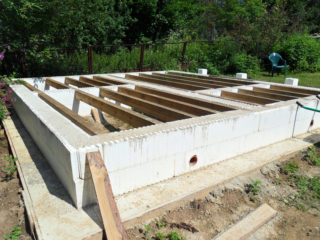
The main enemy of any structure is cold and dampness. Both factors have a devastating effect on the base and wall materials, seriously reducing their design life. Based on this, a technology has been developed for creating external protection for load-bearing structures.
Formwork with blind area is designed to solve the following tasks:
- Creation of a waterproofing layer that prevents the penetration of rain and melt water to the foundation. Thanks to this, a comfortable microclimate in the basement is provided, and the concrete base is not subject to destruction from contact with moisture and reagents in the ground.
- Thermal insulation of the vertical soil layer directly adjacent to the walls of the support system. Freezing of the foundation and the transfer of cold to the living and utility rooms located above it is excluded.
- Protection of external walls from dirt and dampness, which comes from wet grass and splashes during rain.
- Giving the building a finished look. With an external frame around the perimeter, it looks neat and beautiful.
- An additional path for people to move around, wheelbarrows to ride and store garden tools.
To achieve a quality result, before starting work, you must familiarize yourself with the technology for its implementation, study the current rules and regulations.
Key features of the device
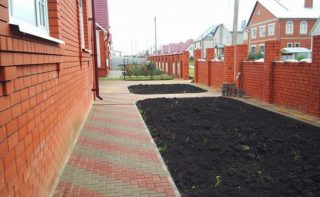
The blind area with permanent formwork is a continuous strip of waterproof material located on the ground close to the base of the house. This structure will effectively perform its functions only if all its parameters are met.
It is recommended to adhere to the standards corresponding to the following parameters:
- Width. This refers to the distance from the wall of the house to the edge of the formwork. The minimum indicator is 100 cm. This is enough to protect the foundation from dampness. The size of the roof overhang is also taken into account. The blind area should be at least 20 cm wider to prevent erosion of the soil by the water flowing from the roof.
- Length. It is understood that the formwork strip should run along the entire perimeter of the building, making a gap at the construction site of the porch, if this is provided for by the project. Damping gaps, which are part of the structure, are not taken into account.
- Thickness. The choice is made based on the plans for the operation of the structure. If it will perform a decorative, protective function and be used for walking, 5 cm is enough. Provided that there will be cars on the track, the minimum thickness is 15 cm.
- Bias. Must extend from the wall to allow water drainage. The optimal angle is 2-3%. This is enough for quick moisture removal from the wall and comfortable walking.Increasing the slope is fraught with the likelihood of falling when moving on a wet blind area.
Taking into account all the criteria and the correct choice of materials will create an effective and presentable formwork.
Formwork types and requirements
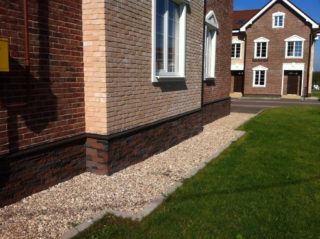
There are many options for arranging a practical and durable blind area using materials at hand and commercially available. Each of them has its own characteristics, advantages and disadvantages.
You can dwell on such solutions:
- Concrete. A time-tested material that is durable, durable and waterproof. The downside is the nondescript appearance of the slab, which spoils the interior of the courtyard. You can improve the look of concrete with dyes, plasticizers and polishing.
- Asphalt concrete. The coating does not allow water to pass through and has a slight plasticity, which is necessary when working on heaving clay soil. The difficulty lies in achieving a flat surface of the slab.
- Crushed stone. Granite stone looks beautiful and picturesque, but allows water to pass through. The condition for laying is the creation of a waterproofing layer of roofing material. In addition, even a dense tamping does not help from deformation of the rubble layer when walking, it must be constantly leveled.
- Paving slabs. A variety of textured fragments makes it possible to create beautiful patterns and drawings along the house. The tile is laid on sand or screenings, under which the waterproofing is laid.
- Ceramic tile. The material can be viewed more as a finish. It can only be laid on a solid foundation, which is a concrete slab. The tile looks very impressive, but at the same time it is slippery and fragile.
When choosing a material, you need to objectively and critically evaluate its performance. The blind area is done for years, there is no point in repairing or changing it every season.
Manufacturing technology
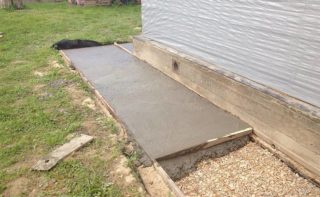
The arrangement of the blind area should begin immediately after the external finishing work.
To make the formwork around the house with your own hands, you will need the following tools and materials:
- level, tape measure;
- Bulgarian;
- hacksaw;
- rammer;
- scissors;
- shovel, hammer, ax;
- waterproofing;
- crushed stone, sand, cement;
- material for creating a track.
The list can be expanded depending on the selected project.
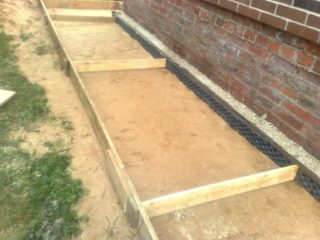
The work on creating a concrete slab should be carried out in the following sequence:
- Draw up a construction scheme, carry out calculations, purchase materials, prepare tools and equipment.
- Mark out, remove the fertile soil layer, dig a trench, level and tamp its bottom. You can treat the land with herbicides.
- Fill in a drainage layer consisting of gravel and sand. Carry out its wetting and alignment.
- Install thermal insulation. The best option is foam plates with a thickness of 5 cm.
- Assemble the formwork for the blind area. Any auxiliary material will work, but it is better to use a 50 mm board. Every 200 cm, transverse sections from the 20 mm rail are installed, performing
- Make a steel frame. A lattice with a mesh of 10-12 cm is made of rods with a diameter of 8-10 mm.The skeleton rises above the base by 2-3 cm.
- Knead and pour in the cement mortar. While it is not frozen, you can wedge pebbles, beads, pieces of ceramics and colored glass into it.
It takes 28 days for the concrete to fully mature.
Common mistakes when creating formwork around the house
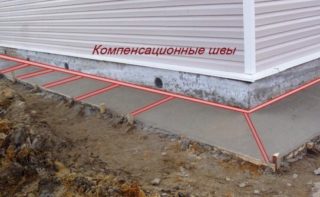
Beginners and inexperienced craftsmen can make mistakes at any stage of formwork manufacturing:
- ignoring leveling and tamping of the bottom of trenches, leading to an uneven height of the pad;
- the use of waste and loose crumbling for filling, which causes voids and subsequent subsidence;
- the absence or too steep slope, when the water will stagnate or it will be slippery and dangerous to walk on the track;
- lack of expansion joints, which leads to cracks and plate splitting;
- use of crushed stone soiled with clay and dirty water to mix the solution.
These mistakes are easy to avoid if you approach the matter thoughtfully and competently, without neglecting the elementary rules of construction.








